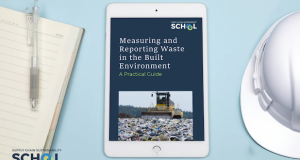DECIDING WHICH AREAS OF SCOPE 3 ARE MOST RELEVANT
The first step towards effective Scope 3 reductions is deciding where to focus your efforts for maximum impact.
There are 15 distinct Scope 3 categories, ranging from business travel to leased assets, all relating to the indirect emissions which come from your business’ value chain. Depending on what your business does, some will deliver more valuable and measurable results than others.
When deciding where to focus your efforts, there are several things to consider.
For each of the 15 Scope 3 categories, begin by using high-level data to determine the contribution it makes to your overall GHG emissions. Then, go a little deeper by using criteria such as size, influence or risk to the business to decide whether the category should be considered a relevant focus area for your business’ Scope 3 emissions reduction activity.
GATHERING YOUR DATA
 Measuring Scope 3 emissions can be challenging as it involves acquiring adequate and accurate data from across the value and supply chain.
Measuring Scope 3 emissions can be challenging as it involves acquiring adequate and accurate data from across the value and supply chain.
In an ideal world, every business would have cutting edge data-management systems and access to accurate, up-to-date information on every product and service used. However, this is rarely the case. For now, the message to businesses is to do the very best you can with the data and resources you have available.
COLLABORATION IS KEY
The administrative challenge of drawing data together from disparate sources and turning it into meaningful information that can be acted upon requires engaging with your suppliers.
This means that successful progress begins with the complex task of engaging a supply chain, which may exist across geographical and cultural boundaries. It’s no mean feat, and will create different challenges for each business.
FOR US, THERE ARE FIVE STEPS TO TAKE FOR BETTER COLLABORATION:
- Set clear expectations for your suppliers. Consider incentivising supply chain partners to improve their carbon reduction measures and their data gathering methods. Have a clear criteria for any new suppliers you enlist, as well as internal procurement targets that have environmental and ethical standards built in.
- Set up interviews with suppliers to better understand their processes and people, and to get a view on where improvements could be made, as well as their obstacles to carbon reduction.
- Facilitate workshops with key suppliers to help them understand where action could be taken on carbon reduction. This will also provide a forum for peer-to-peer support and will help to foster innovation and encourage an exchange of best practices.
- Provide co-branded training materials for your suppliers’ teams, to help them spread the word on net zero and get everyone behind the efforts you are making to reduce carbon.
- Get your internal stakeholders onboard right from the outset. The best results will be achieved by having input and oversight from right across your business, including procurement teams and the c-suite. Your net zero strategy needs to align with broader business objectives if you want to ensure that everyone is invested in driving carbon reduction action forward.
THE BUSINESS BENEFITS OF SCOPE 3
As the importance of measuring Scope 3 emissions grows, facilities managers will increasingly be required to support their business’ sustainability targets by looking at both the carbon impact of the areas they are responsible for and the suppliers they use.
Although calculating Scope 3 emissions can be complex, there are several benefits to taking a proactive approach. The Science Based Targets initiative (SBTi)(vi) has said that companies committed to the initiative are able to demonstrate that creating a climate-secure world supports their successful business operations. This means that having a robust strategy across the whole supply chain is as much about economic resilience as it is about reducing carbon emissions as it will also help to protect your business from future risk.
For those within the value chain of a public sector or a larger corporate organisation, it will increasingly mean the difference between winning a supply tender or losing it.
As well as boosting efficiency and productivity across the value chain, it will also set your organisation apart as a sustainability leader, helping to unlock commercial opportunities as well as retaining and attracting fresh talent.
In our 2020 report, ‘Your Business Blueprint – The Road to Net Zero’(vii), respondents fed back that one of the benefits of having a strong sustainability strategy was attracting the next generation of talent. Potential new recruits are increasingly assessing a company’s climate commitments as well as more ‘traditional’ criteria, so including Scope 3 emissions could be a key differentiator.
That is why we have created a new guide – ‘Scope 3 and Your Road to Net Zero’ – to provide advice and ideas on where to start, which can be downloaded.(viii)
(i) www.gov.uk/government/publications/net-zero-strategy
(ii) www.gov.uk/government/publications/heat-and-buildings-strategy
(iii) www.gov.uk/government/publications/industrial-decarbonisation-strategy
(iv) www.gov.uk/government/publications/transport-decarbonisation-plan
(v) https://sciencebasedtargets.org/
(vi) https://sciencebasedtargets.org/
(vii) https://npowerbusinesssolutions.com/your-business-blueprint
(viii) https://npowerbusinesssolutions.com/scope-3





